RQA Indicator Spotlight: Credit spreads hint at caution among broader stability
This month, we take a closer look at two key measures of corporate bond risk: the ICE BofA US High Yield Option-Adjusted Spread (OAS) and Moody’s BAA–AAA corporate bond spread. Together, they provide a comprehensive read on risk sentiment across both speculative and investment-grade corporate credit markets.
The high-yield OAS has moved higher in recent weeks, rising from approximately 3.6% in early March to 4.16% as of April 16, 2025. This modest increase marks the first sustained widening in spreads since mid-2023, reflecting a recalibration of credit risk as economic and earnings uncertainties re-emerge. Factors contributing to the shift include softening leading indicators, geopolitical risks, and tighter credit conditions impacting lower-rated issuers.
Source: Ice Data Indices, LLC via FRED®. Shaded areas indicate U.S. recessions.
In contrast, the spread between Moody’s BAA and AAA-rated bonds remains subdued, holding near 1.2%, below its long-term average. This relative calm in investment-grade credit highlights that rising risk premiums have not yet spilled over into the broader, higher-quality segments of the market.
Historically, widening credit spreads—particularly in high yield—have preceded both equity market drawdowns and U.S. recessions. During periods like the 2000 tech bust, the 2008 financial crisis, and the 2020 pandemic, spreads surged well in advance of the peak economic stress, acting as early signals of deteriorating corporate fundamentals and reduced investor risk appetite.
While the current OAS level remains well below crisis territory, the recent move off cycle lows should not be dismissed. It reflects a market that is beginning to reprice tail risks, even as overall financial conditions remain relatively supportive. Meanwhile, the stability in investment-grade spreads reinforces that this is a bottom-up, quality-specific repricing rather than a broad-based credit event.
As investors navigate a landscape of elevated interest rates, tightening bank lending standards, and mixed macro signals, tracking corporate bond spreads offers timely insight into where stress is building and how risk is being repriced across the capital structure.
Spreads can serve as a forward-looking dashboard—when they rise meaningfully, they often do so well ahead of equity volatility or economic contraction, offering a chance to reduce exposure or shift toward higher-quality assets before broader risk-off moves unfold.
Economic Forecast Model
Over the last few months, the growth metric in RQA’s Economic Forecast Model has moderated from stable positive near-term growth readings to the zero bound, which suggests growth may be slowing or sluggish in the near term. This shift reflects a combination of gradually softening labor market trends, persistent weakness in manufacturing and housing, and a mixed picture in consumer activity. While services and income growth remain supportive, the broader economic signals are pointing to deceleration rather than continued expansion.
Source: Analysis by RQA. Data from U.S. Federal Reserve; Bureau of Labor Statistics; Norgate Premium Data; Institute for Supply Management.
The RQA Economic Forecast Model represents a consolidated composite of key economic leading indicators and market-based explanatory variables. The goal of this composite model is to present a holistic measure of primary U.S. economic growth drivers and their trends over time. (Additional detail on the model’s construction is provided here.)
Values above the zero-line are indicative of positive U.S. economic growth expectations in the near-term, and therefore, indicate economic strength and lesser chance of recessionary pressure. On the other hand, values below the zero-line represent the opposite - a more negative outlook and more elevated probabilities of the U.S. experiencing an economic contraction.
TAKING A CLOSER LOOK AT THE ECONOMIC DRIVERS
The RQA heat map of economic drivers provides additional insight into the U.S. growth outlook. By examining trends across sectors—such as labor, industrial activity, and financial conditions—we gain a more detailed understanding of the economy's health and trajectory. This breakdown helps us anticipate potential shifts in growth expectations and inflation trends.
Source: Analysis by RQA. Data from U.S. Federal Reserve; Bureau of Labor Statistics; Norgate Premium Data; Institute for Supply Management.
Labor market
The labor market continues to show signs of gradual softening. Non-farm payroll growth remains positive at 0.9% year-over-year in March but has cooled from stronger levels seen earlier in 2024. Initial unemployment claims (inverse YoY) have improved sharply, rebounding to –6.7% from deeply negative readings earlier in the year, suggesting some easing in layoff activity. However, the RQA labor composite remains in contraction territory, at –1.7% year-over-year. That said, the overall labor backdrop remains relatively resilient, particularly in absolute terms, with no indication of broad-based deterioration as of yet.
Commercial output
The manufacturing and housing sectors remain under pressure. The ISM manufacturing PMI has finally turned modestly positive (+0.6% above base), ending a long streak of contraction. However, residential real estate permits posted another decline (–4.1% YoY), continuing their downtrend, and industrial production remains weak, with just 0.1% year-over-year growth. The bright spot is the ISM services PMI, which, while moderating from its October rebound, still stands at a healthy +7.0% above base, showing ongoing strength in the service-oriented side of the economy.
Income and consumption
The income and consumption picture remains solid, supported by steady real wage and spending growth. Real personal incomes grew 3.2% year-over-year in March, while real personal consumption expenditures held at 2.3%. Retail sales have struggled to gain momentum but were flat year-over-year in March after being negative through much of late 2024. The RQA consumer spending composite improved slightly to 1.3% year-over-year, suggesting stable, if modest, consumption activity. While discretionary spending remains uneven, the core trajectory of consumer demand remains intact.
Financials and sentiment
The financial environment remains mixed, with cautious optimism continuing to shape market dynamics. Equity markets have cooled from their late-2024 highs, but the S&P 500 still posted 6.8% year-over-year gain through March. More notably, corporate bond spreads have begun to widen at the margin — as discussed in our indicator spotlight — signaling a modest repricing of risk, particularly in lower-rated credit. Despite this recent shift, spreads remain relatively contained compared to historical norms, reflecting an overall environment of stable credit conditions.
Yield curve spreads continue to flash caution, with both the 10-year minus 3-month and 10-year minus 2-year curves remaining inverted, at –0.1% and 0.3% respectively. These persistent inversions underscore investor concerns about future growth and the potential for policy lags to weigh on activity. Meanwhile, consumer sentiment remains deeply negative year-over-year (–28.2%), though recent improvements suggest a slow rebound from last year’s extreme lows.
Inflation and money supply
Inflation indicators suggest moderating but still elevated price pressures. CPI stands at 2.8% year-over-year, with core PCE at 3.0%, both sitting just above the Fed’s preferred range. Importantly, M2 money supply has flipped positive, up 4.3% year-over-year, reversing the prior contraction trend and pointing to easing liquidity conditions that may provide support for economic activity heading into mid-year.
MARKET REGIME DISCUSSION
After a period of robust performance, the U.S. economy is showing signs of deceleration. Recent data points to moderating inflation and a slowdown in growth, shifting the economic regime toward a more fragile state. This transition is reflected not just in macro forecasts, but also in shifting market sentiment, evolving Federal Reserve policy, and an updated placement within our economic quadrant framework.
Economic Growth Slows Amid Trade Tensions
The International Monetary Fund recently revised its U.S. growth forecast for 2025 downward to 1.8 percent, a notable decline from the 2.8 percent growth seen in 2024. This downward adjustment reflects a backdrop of escalating trade tensions and policy uncertainty following the implementation of new tariffs. Similarly, Fitch Ratings now expects U.S. growth to decelerate to 1.2 percent in 2025, with quarterly growth potentially falling as low as 0.4 percent year-over-year by Q4.
Easing Inflation and Cautious Sentiment
Recent trends suggest that inflation is gradually easing, with both headline and core measures showing signs of cooling. While price pressures remain elevated by historical standards, the direction of travel appears constructive, supporting expectations for a more stable inflation backdrop going forward.
Despite this moderation, financial markets have grown more volatile as investors reassess the balance between slowing growth and evolving policy expectations. Yield curve inversions and fluctuating equity markets reflect ongoing uncertainty, while consumer sentiment remains subdued. These signals point to a market environment that is still navigating a fragile economic transition, with participants watching closely for clearer signs of direction.
Federal Reserve Watch: Patience Amid Cooling Pressures
The Federal Reserve has held interest rates steady through the first quarter of 2025, adopting a more patient and data-dependent approach. While expectations for early-year rate cuts were once widespread, that view has faded. Policymakers have communicated a willingness to wait longer before easing, citing inflation that remains above target despite its recent decline.
Recent FOMC communications show a growing internal debate about the trajectory of inflation and the resilience of the labor market in the face of slower growth. While the Fed has not ruled out one or two rate cuts later this year, markets have moderated their expectations accordingly. The Fed appears focused on avoiding premature action that could risk undoing progress on inflation.
Looking forward, the Fed’s posture will likely be shaped by how the balance between inflation and growth continues to evolve. Should labor market softness accelerate or inflation fall more decisively toward target, the case for policy easing could become more compelling.
Economic Quadrant Analysis: Transitioning to a Fragile Regime
Our updated regime framework reflects a meaningful shift. Inflation is no longer accelerating, but it remains above trend. Meanwhile, forward-looking growth expectations have faded, pushing the current regime out of the "inflationary boom" zone and toward a more fragile, low-growth quadrant.
This transition suggests a more cautious environment ahead. Investors are navigating conditions where cyclical momentum is weakening, inflation is decelerating but not yet contained, and policy risks remain elevated. In this setting, asset class leadership often rotates, with higher-quality credit, shorter-duration fixed income, and selective equity exposure performing more defensively. The regime picture suggests the importance of flexibility, downside protection, and close attention to policy signals in the months ahead.
Source: RQA.





